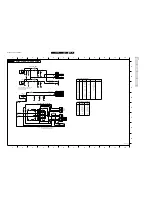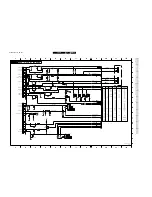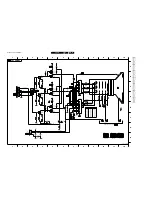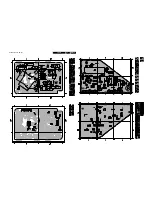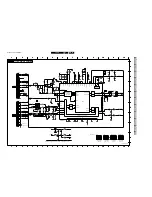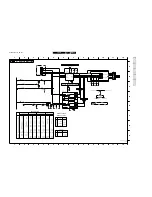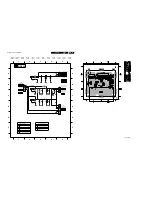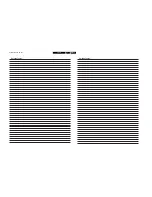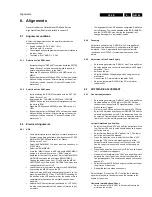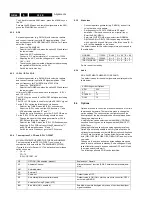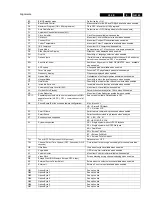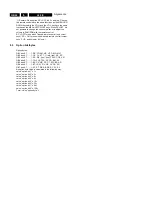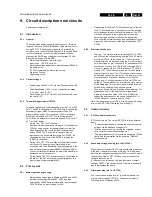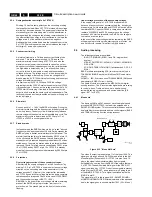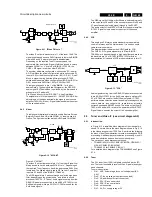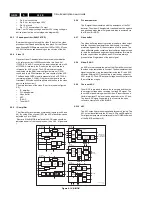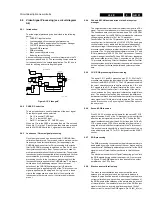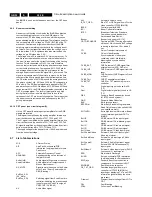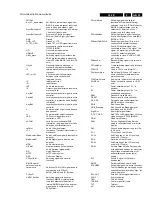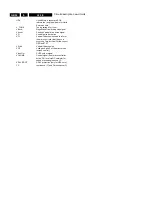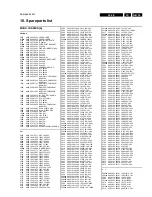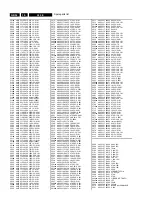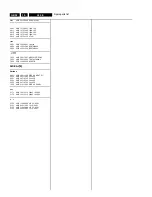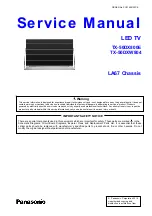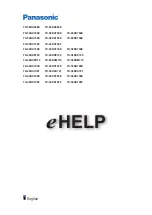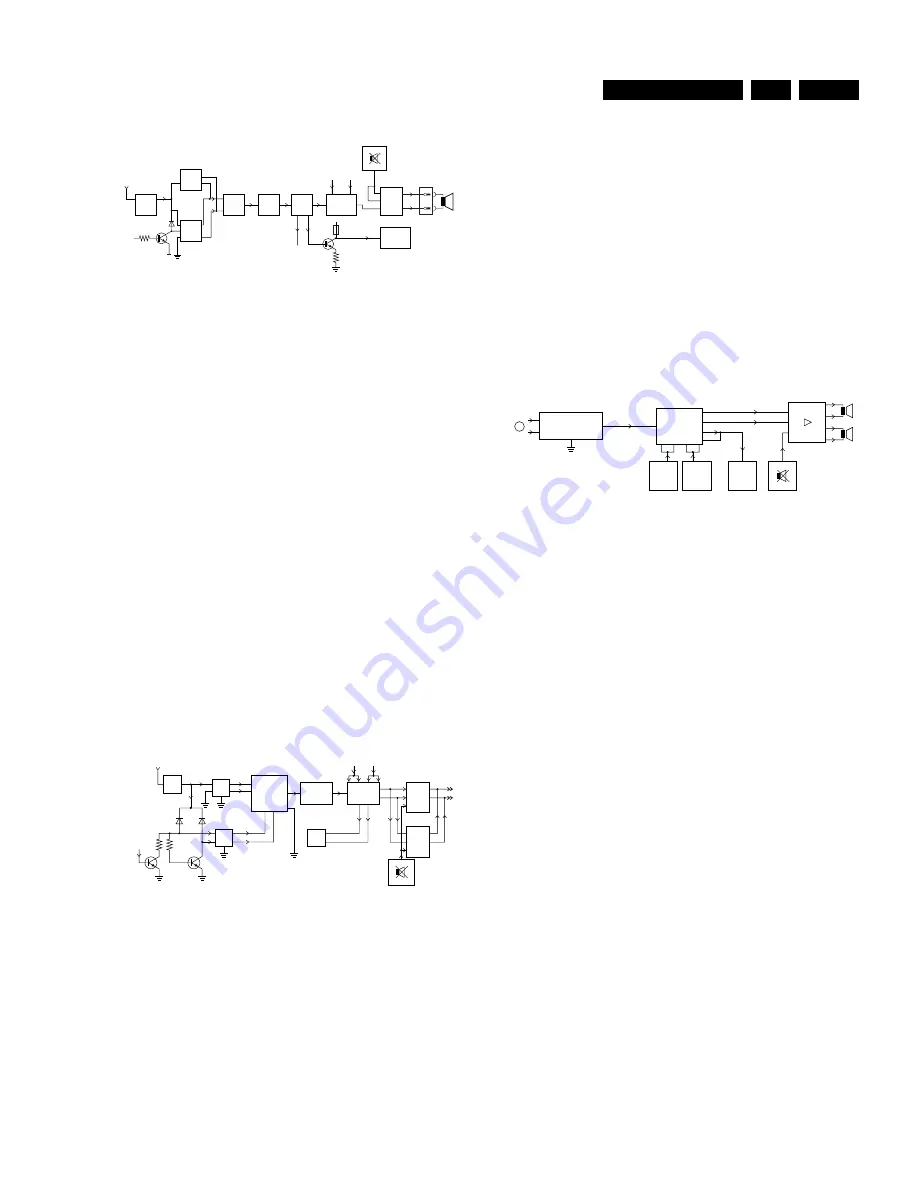
Circuit description new circuits
GB 49
L9.2E
9.
Figure 9-11 "Mono FM sets "
The video IF output is present at pin 11 of the tuner 1000. This
signal goes through a sound SAW filter and is fed to the BIMOS
via pins 48 and 49, where the signal is demodulated.
Depending on the required Tuner frequency band, the
appropiate filter is selected. Signal LLp/Mtrap is used to switch
between NICAM l or L'. At pin 6 of BIMOS IC 7250-A, the
CVBS + SIF signal is fed to another SAW filter.
The system hardware configuration, option code SY, is set at
AD - Dual Mono for a Dual configuration, while option code SY
is set at SS for the Mono configuration ( BG,I, DK, M ). Duall/
Mono, a signal coming from the Micro-processor IC7600,
switches between two Mono configurations ( BG/DK or BG/I or
DK/I ) and selects SAW filter 1001 or SAW filter 1002.
This signal goes back to pin 1 of the BIMOS , for further
demodulation. The demodulated FM-signal or the REAR I/O
audio signal, EXTAudioMono, is switched by the Bimos and is
present at pin 15 and pin 55.
Pin 55 goes directly to the I/O SCART - AudioOutL/Mono.
The signal at pin 15 is fed to panel A11 - SMART SOUND. After
adjustments of the bass and treble, the signal goes to sound
amplifier 7953 ( 2W - Mono ). Signal Volume enables the output
of the sound amplifier.
9.4.2
Nicam
This high quality digital audio format is used in Eastern Europe,
Belgium, France, and UK, while NICAM LL' is being used in
France. The figure below shows the AUDIO path for NICAM..
Figure 9-12 "NICAM"
Figure 9.2 "NICAM "
The video IF output is present at pin 11 of the tuner. Signal LLp/
Mtrap is used to switch between NICAM L or L'. Depending on
the required Tuner frequency band, the appropriate SAW filter
is selected. The filtered signal is fed to SIF (sound I.F amplifier)
input pin 55 and 56 of the BIMOS - TDA8845.
The QSS signal at pin 2 passes through a selected high pass
filter, depending on the system used, and is fed to sound
processor 7803, D1 - ITT panel. Audio signals coming from the
REAR I/O panel are connected to pin 49/50 of IC7803 for the
Ext1Audio signals, while pin 52/53 of IC 7803 are used for the
Ext2 Audio signals.
The QSS-signal, Ext1Audio or Ext2Audio is switched internally
to the output pins 28 and 29 of the sound processor. Pin 36 and
37 pass the same selected signal through to the SCART.
The audio output of the MSP3415 is fed to the power amplifier
IC 7953. Signal Volume enables the output of the sound
amplifier.
9.4.3
2CS
This analogue F.M stereo audio standard is predominately
used in Germany and The Netherlands. It is used on some
cable television networks.
The diagram below indicates the AUDIO path for 2CS.
The CVBS + SIF signals present at pin 6 from BIMOS, -
TDA884x-, are passed through a high pass filter and are then
fed back into pin 58 of IC 7803 (MSP3415D) for further
demodulation. All variants of 2CS are demodulated in this IC.
Figure 9-13 "2CS"
Audio signals coming from the REAR I/O panel are connected
to pin 49/50 of IC7833 for the Ext1Audio signals, while pin 52/
53 of IC 7803 are used for the Ext2Audio signals. IC 7803
performs source selection as well as audio processing such as
volume, balance, tone control, mute, spatial stereo, incredible
surround sound and SMART sound. The audio output from IC
7803, pin 28 and pin 29, is fed to the power amplifier IC 7953.
Signal Volume enables the output of the sound amplifier.
9.5
Tuner and Video IF (see circuit diagram A5)
9.5.1
Introduction:
In Figure 9.15 a simplified block diagram of the video path is
shown. The main item in the block diagram shown in Fig.9.14
is the video processor item 7250. The IC performs the following
functions, video IF demodulation, chroma processing and RGB
processing. Additionally synchronisation processing, mono IF
audio demodulation and audio selection takes place.
Two versions of video processors are used:
•
TDA8841/42 N2 for SW CENELEC BG/DK, CENELEC I
NICAM, CENELEC BG NICAM
•
TDA8845 N1 for CENELEC BG,LL',I
For a detailed block diagram of the TDA8844/8845 see Figure
9.14.
9.5.2
Tuner
The PLL tuner (item 1000) is digitally controlled via the I2C-
bus. The tuner is suitable to receive off-air, S-(cable) and hyper
band channels.
Tuner pin description:
•
Pin 1: AGC, Automatic gain control voltage input (0.3 -
4.0V)
•
Pin 2: VT, tuning voltage input (not connected)
•
Pin 3: AS, address select (not connected)
•
Pin 4: SCL, IIC-bus serial clock
•
Pin 5: SDA, IIC-bus serial data
•
Pin 6: not connected
•
Pin 7: Vs, PLL supply v5V
SOUND
AMPLIFIER
CL 96532028_007.eps
290399
MONO FM SETS
6
1001
8842
7250
7250
1204
1005
8842
7
1000
15
5
3
BASS
TREBLE
SMART
SOUND
7953
LEFT
7254
SCART
+5V
MONO
2
55
EXT AUDIO
MONO
48
49
µp
TDA 7057
CL 96532028_006.eps
290399
1000
1005
1204
SCART
NICAM
1
2
3
P2LLP/MTRAP
7001
7002
3
1
2
4
5
55
56
15
7250-A
4
5
48
49 VIF
TDA 8845
FILTER
SELECTION
2
58
52
53
49
28
29
50
EXT 1
AUDIO
EXT 2
AUDIO
36
37
MSP 3415
7833
7953
TDA 7053
7951
L
+
/L
-
R
+
/R
-
L-OUT
R-OUT
11
2CS
TDA 8841/42
R
+
L
+
R
-
L
-
8
13
10
11
7953
7803
EXT. 1
AUDIO
EXT. 2
AUDIO
CL 96532028_005.eps
290399
48
49
7250-A
(CVBS+SIF)
6
5
3
MSP3415
52
53
49
50
58
28
29
36
37
IF
LEFT OUT
RIGHT OUT
15
SCART
Summary of Contents for L9.2EAA
Page 5: ...Directions for use GB 5 L9 2E 3 3 Directions for use ...
Page 6: ...Directions for use GB 6 L9 2E 3 ...
Page 7: ...Directions for use GB 7 L9 2E 3 ...
Page 31: ...Schematics and PWB s GB 31 L9 2E 7 ...
Page 32: ...Schematics and PWB s GB 32 L9 2E 7 ...
Page 38: ...Schematics and PWB s GB 38 L9 2E 7 ...
Page 42: ...Schematics and PWB s GB 42 L9 2E 7 Personal notes Personal notes ...

